|
Waverley approaching Clacton Pier at 12.15 on 6 October 1999 |
Thames Swansong
by Martin Longhurst
Updated 12 October 1999
Update 2 October 1999
With her South Coast season abruptly ended by forecast bad weather, Waverley sailed for Tilbury on late on Monday 27 September. She sailed from Southampton at about 1700 hours to sail direct for the Thames. Consequently, the scheduled cruise from Swanage and Sandown on Tuesday 28 September, and that from Portsmouth, Worthing and Eastbourne on the Wednesday, had to be cancelled.
Thursday's cruise was capable of partial salvation, however. The timetable was to sail from Folkestone to London Tower Pier direct. With the paddler lying at Tilbury, the passengers were coached from Folkestone to join her there. Leaving the Landing Stage at 12 noon, a cruise was given downstream to the Medway an then up to London. before dropping off the passengers at Tower Pier. In the event, the forecast was wrong and there was a flat calm at Folkestone!
There had been considerable worry over the preceding weeks concerning the availability of Tower Pier. It was being reconstructed and the project was due for completion in September. Fortunately it had been finished sufficiently for Waverley to tie up and the contingency plans to use tenders were not required. However, it was not possible for Waverley to lie there overnight and she had to return to Greenwich or Tilbury each day.
Friday was a success, with about 370 on board for the Thames Forts cruise during the day and another 350 for the evening PSPS charter.
Saturday's cruise was due to go to Clacton. Again the weather forecast had promised rain, wind and gales. In the event, the rain stopped and the wind dropped just before the paddler left her mooring at the Tower. The sun shone all day and the seas were kind. Good numbers were carried all day, including 170 for the one-way sail from Clacton with coach return.
Update 3 October 1999
Another excellent day against the prediction of the forecasters! Sun for the whole day with just one shower.
Over 500 joined the paddler at Tower Pier with more boarding at Tilbury where the total complement was 602. A good exchange of passengers took place at Southend before we steamed off for the Thames Forts. As in most years on this cruise, the Southend Inshore Lifeboat (which lives at its Boathouse at the Pier Head) gave a demonstration around the ship while RNLI collectors shook the boxes at the passengers. We passed Red Sands Fort and headed further east to turn back just passed Shivering Sands Fort.
Good time was made back to Southend to provide an opportunity to take water. This is quite a problem on the Thames as few piers have water available and consumption is high.
An evening cruise to the Tower was offered from Southend (with coach return from Tilbury) and Tilbury. This option was also popular. However, the disembarkation at Tower Pier was very slow. This is because the design of the new pontoon only allows space for one narrow gangway to be used.
Tower Bridge is excellently floodlit nowadays and watching the bascules raise is always an exciting moment.
After tying up at Tilbury, the stewards work was not over as they had to unload a lorry full of stores brought from the Balmoral at Bristol.
However, Monday is due to be an off-service day which allow some time for relaxation.
Update 6 October 1999
Following Monday off service at Tilbury, Waverley sailed at 0500 for Margate. Unfortunately, in the event there was too much swell to attempt coming alongside the unyielding stone of Margate Pier. Passengers were therefore transferred by coach to join the ship at her next port of call, Whitstable. Over 350 embarked on this otherwise perfect day for the up-river cruise to view the Millennium Dome and Tower Bridge. Further pick-ups at Southend and Tilbury brought numbers to 15 less than the passenger certificate limit (800).
The numbers involved, and difficulties berthing at Whitstable, meant that Waverley missed her booked bridge lift at the Tower and entered the Upper Pool with sailing barge Cabby at 1630, the time she was due to leave. Nowadays, it is the practice to leave at least 20 minutes between lifts so as to minimise traffic congestion. So Waverley had to stem the tide awaiting her time to steam back down river.
Wednesday's programme started at Southend with 3 coach loads on for the single sailing to Ipswich.
|
Waverley approaching Clacton Pier at 12.15 on 6 October 1999 |
Additional passengers joined at Clacton and Walton, bringing the total to 250. Then Waverley turned northwards towards Felixstowe.
|
The Haven Pilot Cutter 'Pioneer' |
The pilot boarding the after starboard sponson door |
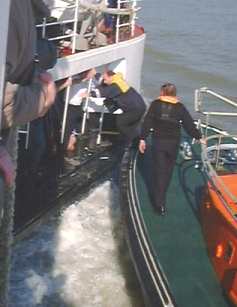 |
After picking up the Haven Pilot, we steamed past the Container Port, now reputedly one of the busiest in the world.
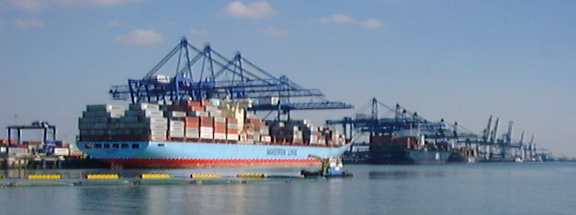 |
Then into the River Orwell for the picturesque passage to Ipswich.
|
|
| Sailing under the Orwell Bridge on
the last part of the journey to Ipswich View from the Bridge by Steve Sedgwick |
|
On arrival at Ipswich, it was found that the allotted berth was between two large ships and the gap would be insufficient to allow the paddler to manoeuvre in and out. Captain Colledge had no option but to continue to the far end of the docks where, fortunately, there was a vacant berth. This was within the oil terminal and it was not permissible to land passengers here. So the cant rope was set out and eventually the steamer was turned and taken back downstream to a conveniently vacant length of ordinary quay wall.
With the Southend passengers exchanged for those from Ipswich,, Waverley set sail back to Felixstowe. After passing the Container Port once more, a short diversion up the River Stour took place to view Harwich Parkestone Quay. Here Admiral of Scandinavia was preparing for her 1630 departure to Hamburg.
DFDS Seaways' Admiral of Scandinavia alongside at Harwich Parkestone Quay |
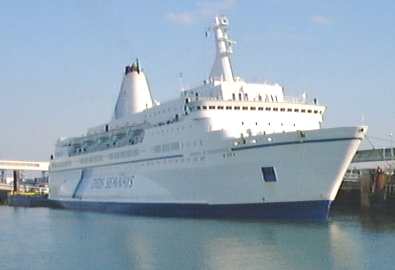 |
And then back out to the open sea for the final southward leg to Walton and Clacton.
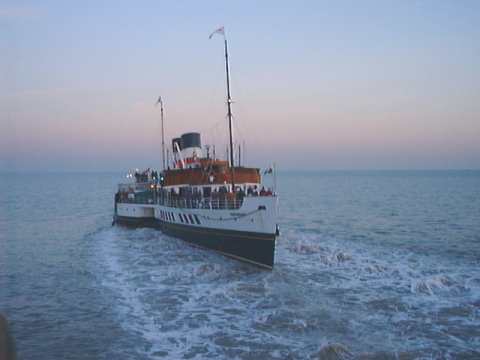 |
Waverley going astern from Clacton Pier at 1805 on 6 October 1999 |
Just before sunset, the paddler steamed back to the north to spend the night at Ipswich.
Reports of advance ticket sales suggested that Thursday's cruise from Ipswich, Walton and Clacton to Tilbury, via the Pool of London, would be a sell-out. Excellent news.
Update 9 October 1999
Thursday's cruise from Ipswich was delayed by 50 minutes awaiting a pilot. Wind conditions were more lively than the previous day and it was decided to coach passengers from Walton and Clacton to join the ship at Southend. Overall, the steamer was 2 hours late by the time she got back to Tilbury, having turned at the Tower. Whilst Waverley was sailing up the Thames, reports Jeremy Gold, the Jubilee Line Extension platforms at London Bridge were opened to the public. Not to be out done, Roddy McKee reports that the first Croydon Tramlink tram (2536) reached Beckenham Junction under its own power at 1506. So now you know!.
On Friday, a day cruise from Southend to the Tower was offered. Well over 500 were on board for the trip, which was concluded some 40 minutes early at 1735. This allowed plenty of time to take water - an essential requirement when large numbers are on board. There was also an upriver evening cruise with coach return and this carried over 400 souls.
Whitstable was the destination of Saturday's sail from Tower Pier. We were blessed with the company of Mr & Mrs McGowan on this journey, but Jean's knees were kept firmly under wraps on this occasion. Leaving Southend 646 were aboard, which was according to plan, as space had to be left for single journey passengers from Whitstable.
|
Waverley tied up on the western side of Whitstable Harbour. |
Bunkers were taken at the Kent port while passengers enjoyed an hour and a quarter ashore, many purchasing sea foods from the fish market by the Harbour. 692 were aboard for the first leg back to Southend, 325 for the round trip from Whitstable. These passengers were conveyed home in no less seven coaches.
With both her whistle and her siren sounding, Waverley heads back downstream to her overnight berth at Greenwich Pier. |
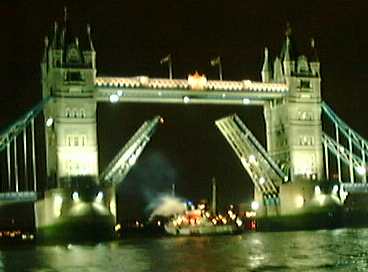 |
Update 10 October 1999
A beautiful cloudless sky greeted travellers at Tower Pier as they joined the Waverley today. Excellent numbers were lifted at the Tower. On the passage downstream, steam whistle salutes were exchanged with the inbound Clyde 'puffer' VIC56, now privately preserved. With the addition of passengers from Tilbury and Southend, 719 were aboard for the cruise down the Medway. A coaster, the Ara, proceeded sedately up the Medway in front of the paddler, reducing progress somewhat.
Paddle steamer Kingswear Castle came into sight in Gillingham Reach, and steamed to stop abeam of her larger sister while the latter shaped up to swing round. The turn was made close to the Chatham Bullnose, assisted by the little tug Horton, which had followed us across the Estuary from Southend. The master of the Horton was also acting as the ropeman at Tilbury, so he had a busy afternoon!
Then followed a series of passes by the two paddlers. Firstly the KC steamed past the Waverley to port and then crossed her bow. The two steamers exchanged the traditional three blast whistle salutes and each ship's passengers gave the other's three cheers. Then the KC dropped back down Waverley's starboard side to give all passengers a good view. Next, she dropped back to round Waverley's stern before coming in for a close pass along the port side. Finally, after a further exchange of whistle blasts, the two steamers parted company.
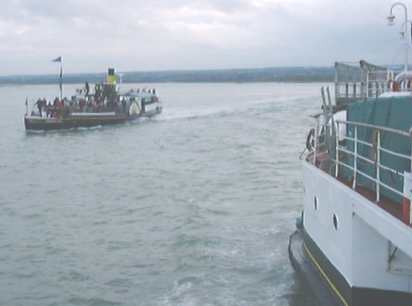 |
The remainder of the voyage was uneventful, with the addition of evening cruise passengers from Southend and Tilbury. Finally, the paddler left London for the last time this century and for the last time in her present form.
Update 11 October 1999 - Three Paddle Steamers Day
Monday's cruise was a short and quiet one by Thames standards, leaving from Tilbury at 10.15, back at 17.15. 118 joined at Tilbury and a further 143 at Southend. The objective was to get these passengers to see the Paddle Steamer Medway Queen at her berth at Damhead Creek, off the River Medway. Damhead Creek is a tidal backwater, too shallow for the Waverley. The solution was to transfer people across to Kingswear Castle, which is able to traverse the Creek at high tide.
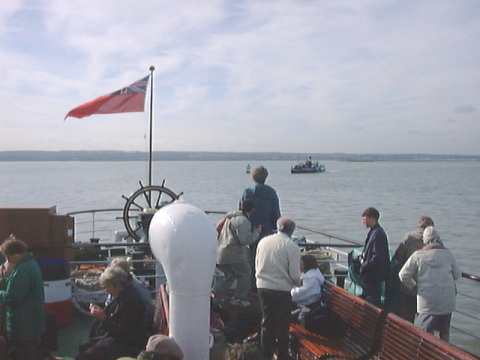 |
Waverley anchored near Oakham Ness Jetty while the KC approaches. |
The day was bright and warm and the sun sparkled on the waters of the Medway. |
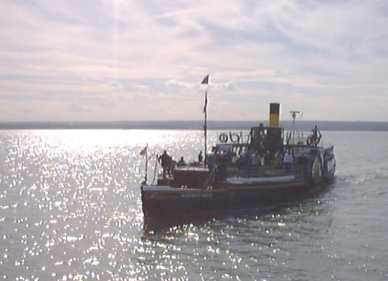 |
|
The final approach as KC comes alongside the Waverley. |
Mooring lines are passed between the ships. |
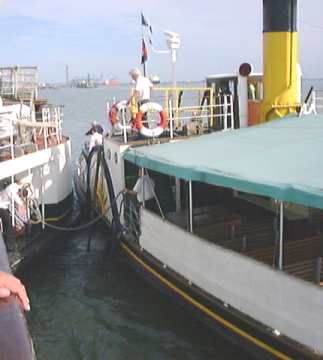 |
 |
Passengers file across to join the KC. |
Altogether 191 sailed up Damhead Creek to see the Medway Queen. |
 |
|
From KC's deck, Waverley seems to tower above you. |
The Waverley house flag flies above KC's wheelhouse. Behind the wheel, Waverley's Graham Gellatly studies the chart, while on the landing platform Waverley's bosun, Tommy Reilly, prepares to go up the creek. |
 |
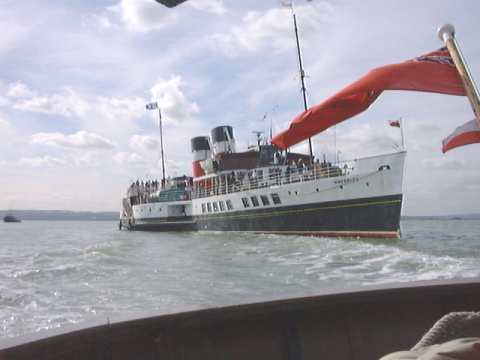 |
KC's red duster flutters as she draws away from the Waverley. |
The Medway Queen lying at her berth. Her funnel has been removed for safety reasons. Behind her the new Damhead Creek Power Station is under construction. Jeremy Gold has noted this information! |
 |
|
With the funding contract for her new boiler now signed, a new plaque acknowledging the support of the Heritage Lottery Fund has been fitted above KC's engine. |
While the KC visited the Medway Queen, the Waverley cruised further up the Medway, turning just below Thunderbolt Pier. Here she has returned to the anchorage and KC is shaping up to come alongside once again. |
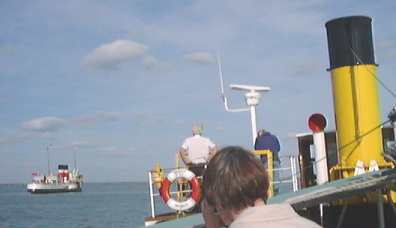 |
|
The two steamers lie together for the transfer back to take place. Waverley is flying the Welsh flag at her jackstaff in recognition of Captain Colledge's nationality, while the black ball above the forecastle signals that she is at anchor. |
Waverley's purser Jim MacFadzean visits KC while the transfer takes place. |
 |
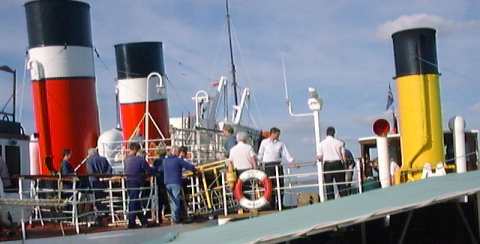 |
Three funnels from the steam age. |
Transfer complete, the KC backs away. |
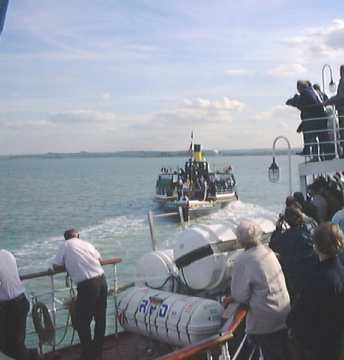 |
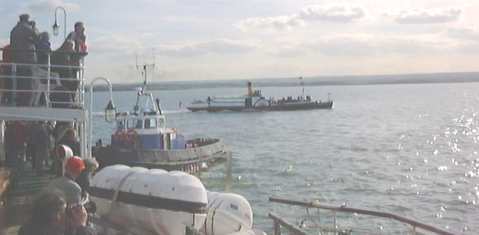 |
The KC heads back to Chatham while the tug Horton comes in to assist turning the Waverley back for Southend. |
The return voyage to Southend and Tilbury went ahead according to schedule. The steamer was to spend her last night on the Thames this century alongside the Landing Stage at Tilbury, ready for her departure the next day to western waters.
Update 12 October 1999
A glorious blue sky greeted the 172 passengers joining the mighty paddler at Tilbury. The timetable included calls at Southend and Whitstable before the sail round the Foreland to Folkestone. Steve Colledge remained in command, while Graham Gellatly joined the ship as an additional watch-keeping officer. Among the passengers were four members of the Kingswear Castle's crew.
Leaving Southend, the steamer was delayed by shipping movements. A coaster crossed our path heading north and a large car carrier took priority as she came out of the Medway for the main channel. A very large crowd of passengers awaited the paddler's arrival at Whitstable. Altogether 576 partook of the trip to Folkestone.
Apart from a little rolling as we rounded the North Foreland, the sea was a flat calm and the sunshine unbroken. A tight timetable meant that we took a course straight across Deal Bay. Approaching the Port of Dover, we encountered the P&OSL Dover and the HoverSpeed Rapide inbound from Calais and Oostende respectively. Purser Jim put on Vera Lynn singing 'The White Cliffs of Dover' as we passed astern of the P&OSL Canterbury.
 |
Who's got a silly hat now? |
The music accompanying Shakespeare Cliff was the 'Waverley Polka.' Captain Colledge brought the paddler into Folkestone Harbour in an impressive sweep, using her astern power to bring her to a rapid halt. The state of the tide was such that, unusually, a gangway could be put out onto the top of the quay wall. Normally it is necessary to put a gang way out onto the steps in the stonework. While the passengers steadily filed off the ship, the deck crew got busy putting the storm boards in lace for the light passage. This was due to take the steamer to Avonmouth by Thursday morning, with a fuel stop early on Wednesday morning at Weymouth.
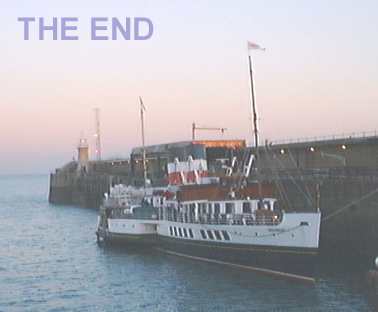 |